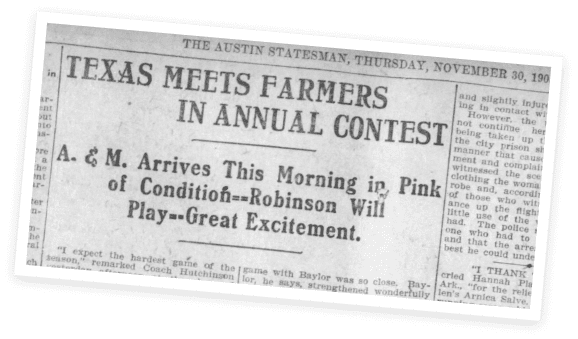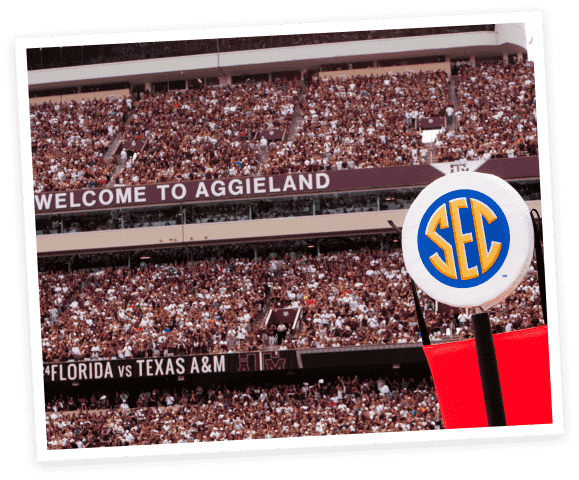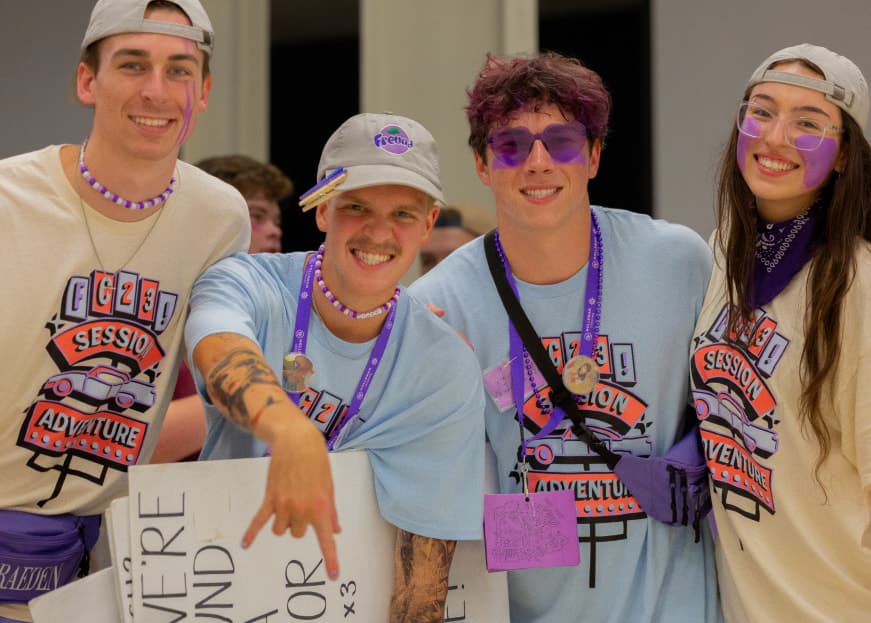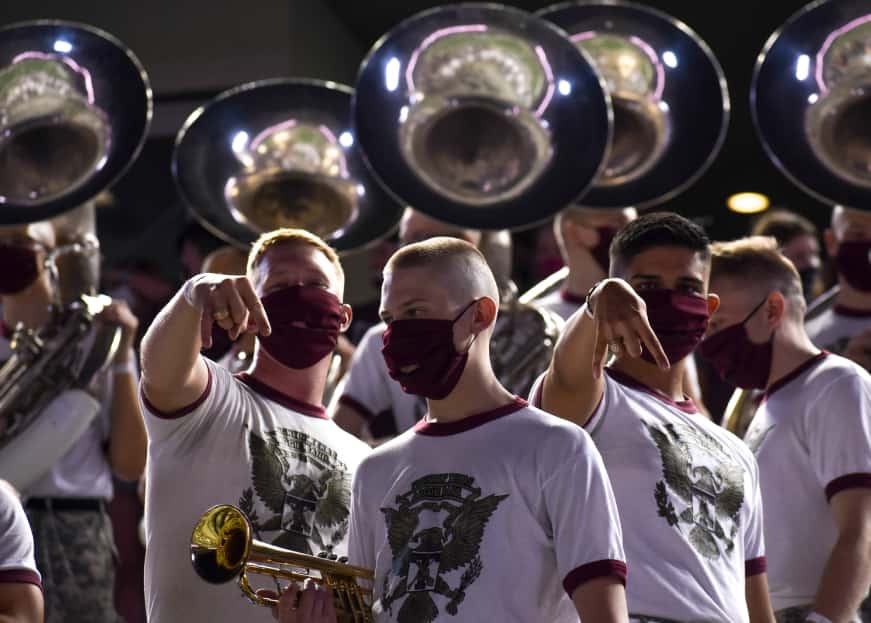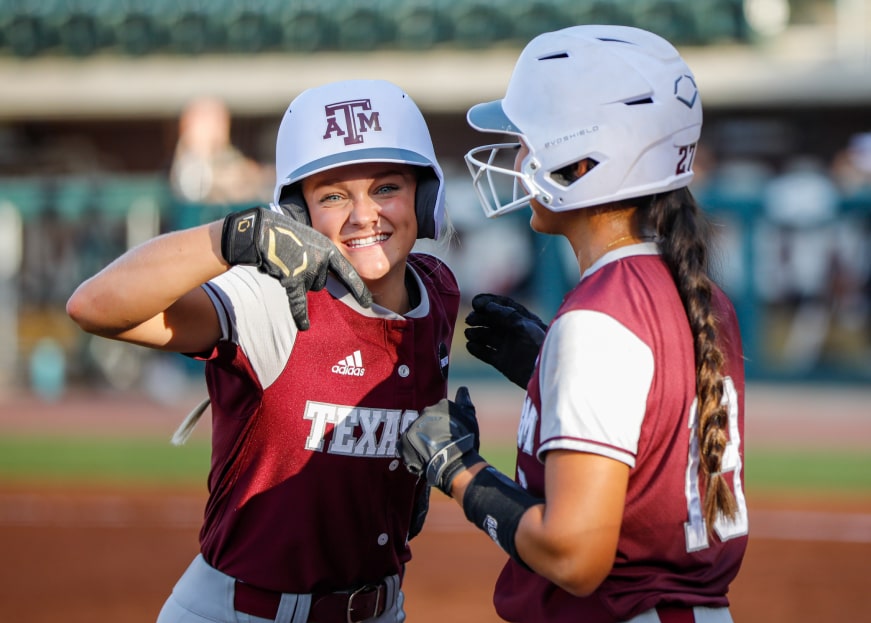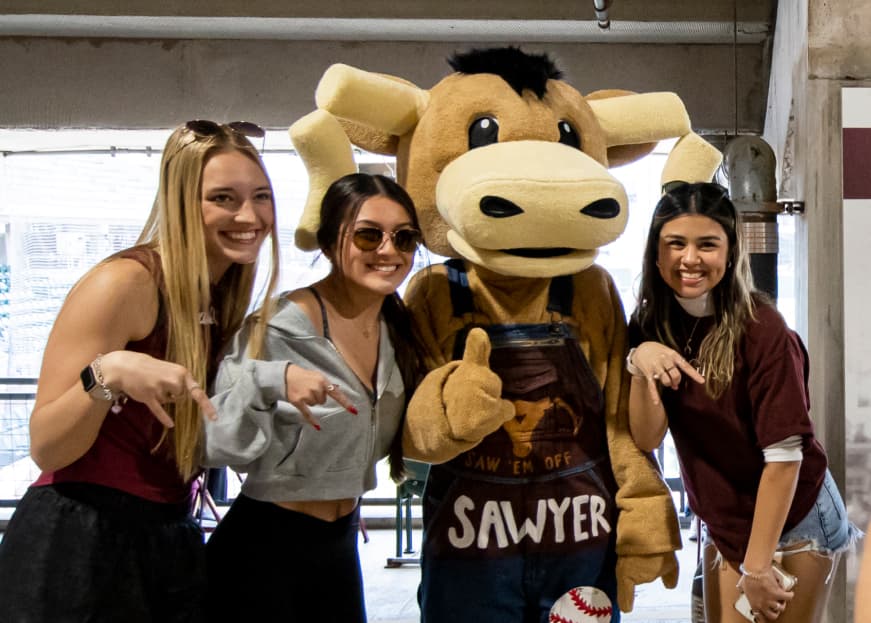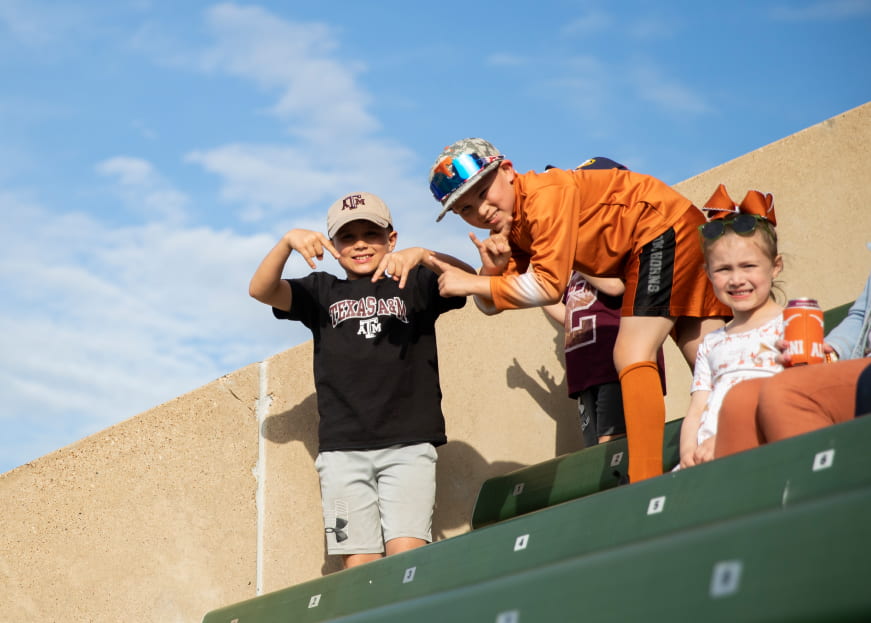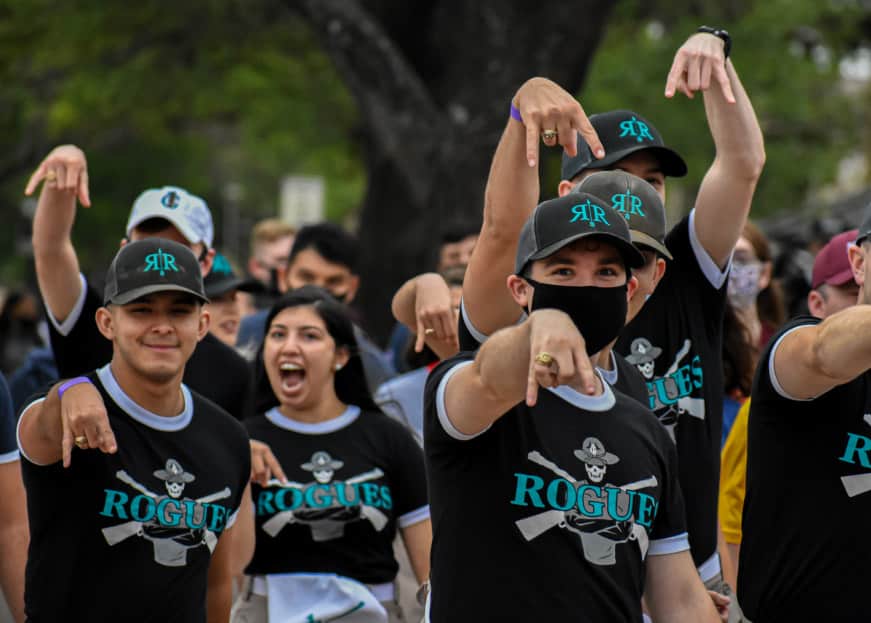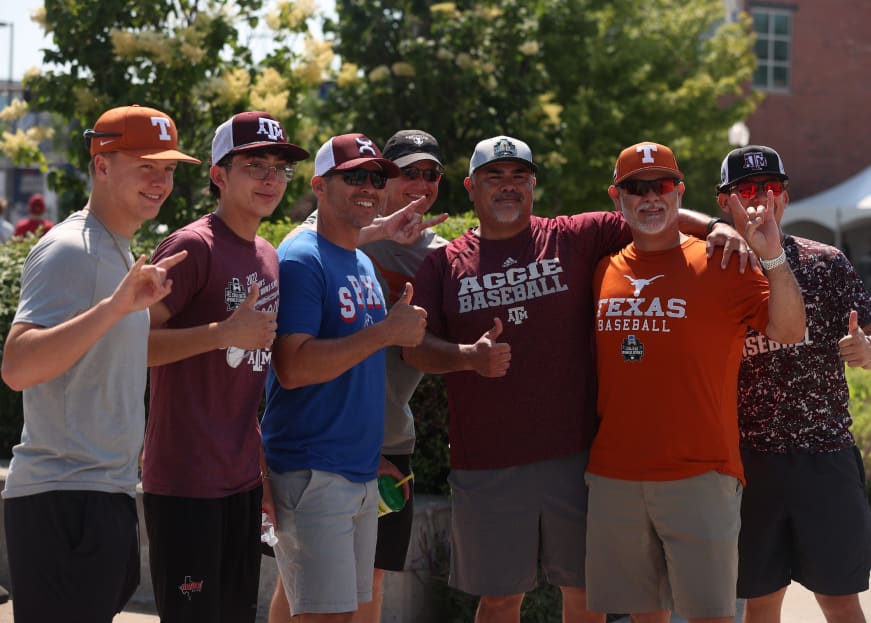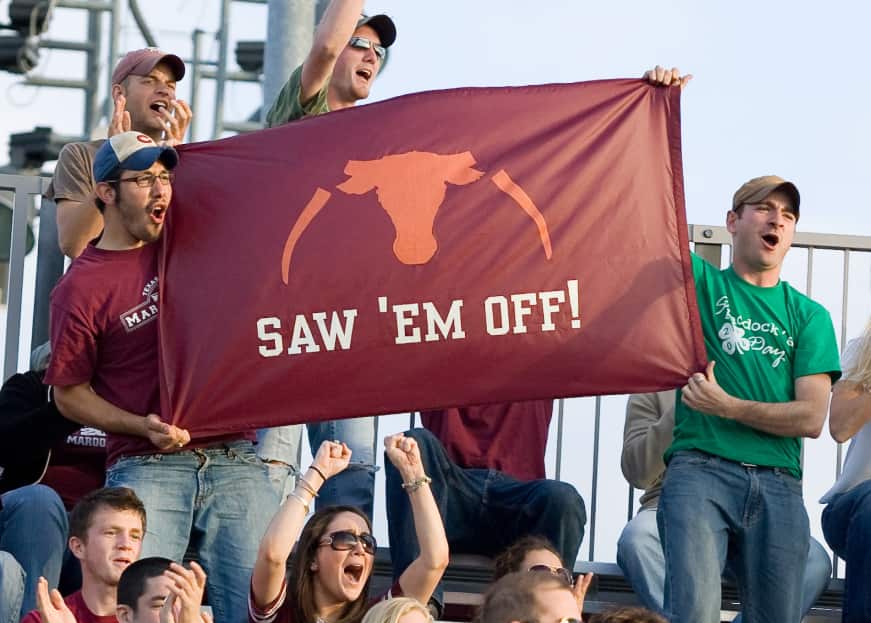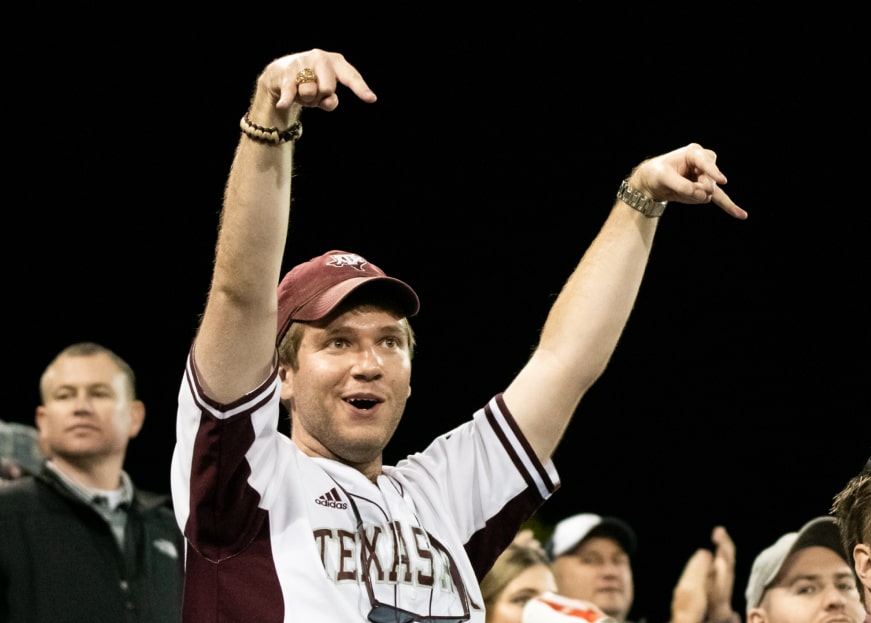As a second-generation Aggie growing up, I've been trained by my father to love everything Texas A&M and hate everything Texas University. Both of us agree that I actually chose to go to Texas A&M for college early on when I was in kindergarten in 2002. One day, my kindergarten class was given an assignment to cut out certain specific shapes out of construction paper and glue them together to form the shape of a longhorn. I strongly refused! I told my teacher, "My family doesn't like longhorns!" After a lot of back-and-forth arguing, my teacher had to call my parents at home. That encouraged me enough to glue the horns to my longhorn's head. However, while she wasn't looking, I later folded the horns in, and the art piece remains glued and framed like that in my house to this day.

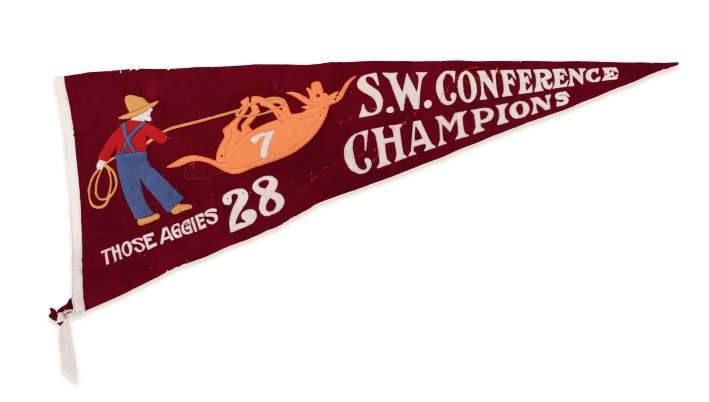
130 Years of Family Feuding
Mascot-nappings, fight songs, nicknames, Bonfires and Hex Rallies: Not all the biggest moments in the Texas A&M University and University of Texas rivalry have happened on the field.
As the schools renew their football matchups, we look back through the years. There have been plenty of shenanigans, and some moments of true support. Let’s revisit some of the memories!
By Sue Owen ’94

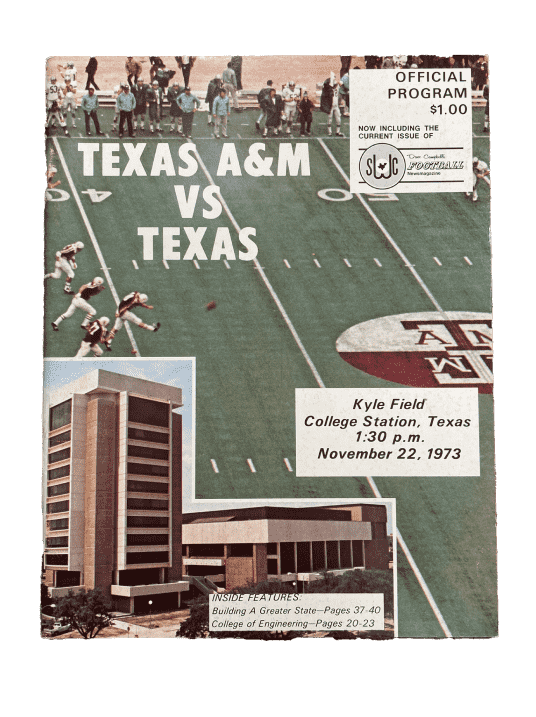
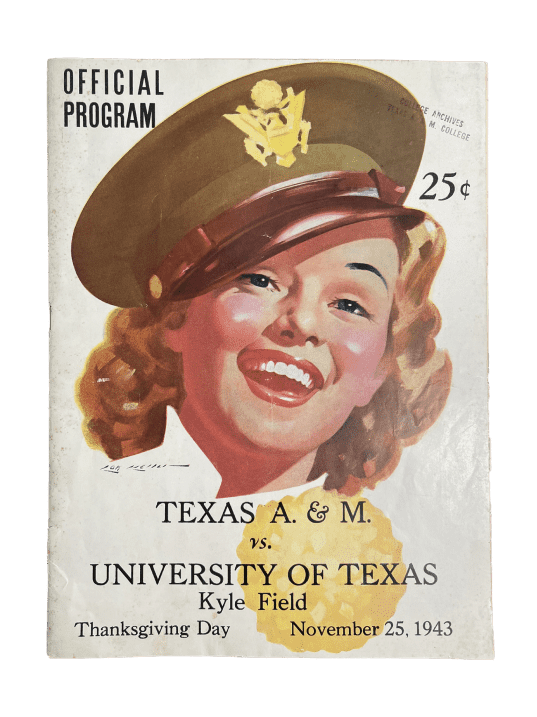

Football programs and pennant courtesy of Texas A&M Cushing Memorial Library and Archives
Filter By ?
Select an icon to see similar or related items. For example, choose 🐾 🐮 to view items relating to mascots Reveille and Bevo, or 🔥 to view items about Texas A&M’s Bonfire and UT’s Hex rally. Click the same icon again to reset the timeline.
Select an icon to see similar or related items. For example, choose 🐾 🐮 to view items relating to mascots Reveille and Bevo, or 🔥 to view items about Texas A&M’s Bonfire and UT’s Hex rally. Click the same icon again to reset the timeline.
1876

Texas A&M opens as the Agricultural and Mechanical College of Texas, the state’s first public institution of higher education.
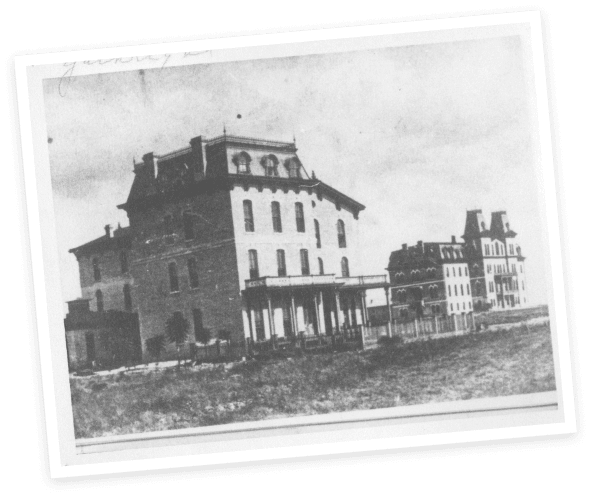
This photo of Texas A&M in 1877 shows the first two college buildings: Steward’s Hall in the foreground, with dorm rooms, the president’s residence and the mess hall, and Old Main in the background.
Photo by Larry Jene Fisher/Texas A&M Cushing Memorial Library & Archives
1883

University of Texas opens.
1893 
UT fields its first football team, known as “Varsity.”
1894 
Texas A&M fields its first football team; their first game is Oct. 20, 1894, against UT’s “Varsity” – the first intercollegiate football game in Texas. The teams do not play again until 1898.
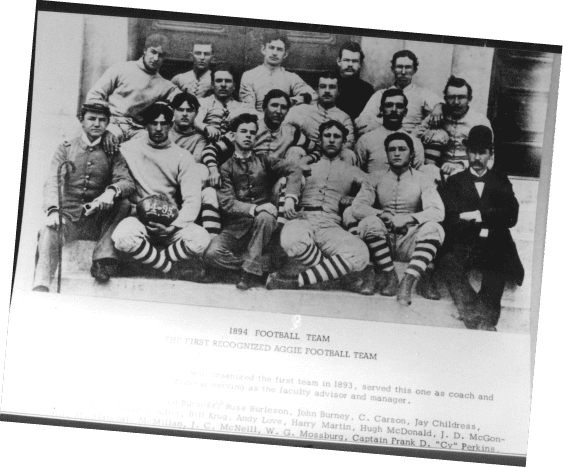
Texas A&M’s 1894 football team.
Photo courtesy of Texas A&M Cushing Memorial Library & Archives
1900

The two teams’ first Thanksgiving game is played Nov. 29. It was actually the second time they played in 1900, having met Oct. 27 in San Antonio (they played twice a year several times in the first decade of the 1900s).
The history of Texas A&M and UT playing on Thanksgiving began on Thanksgiving Day in 1900, and the two teams played on Thanksgiving Day in 2011, but the game did not always fall on Turkey Day in the years between. The many variances include 1900-1909, when the teams sometimes played twice per year, and 1994-2007, when the teams mostly played on the day after Thanksgiving.
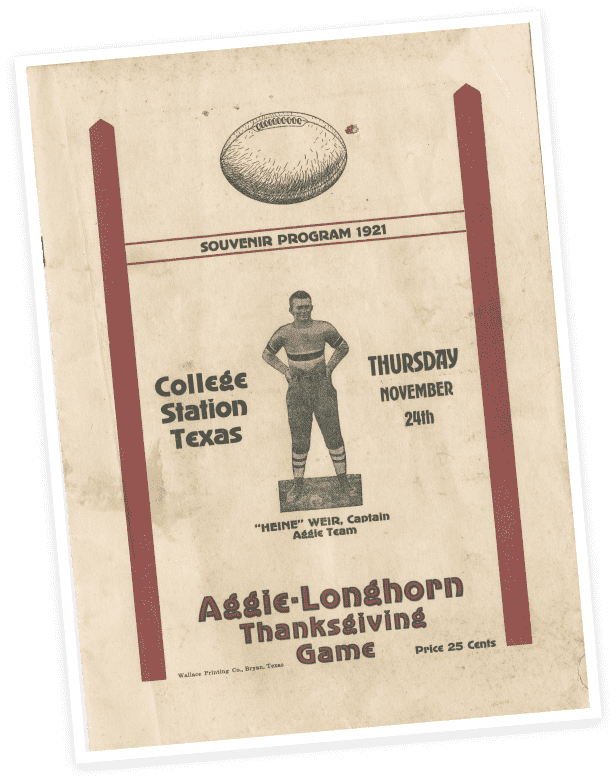
1921 football program courtesy of Texas A&M Cushing Memorial Library & Archives
1907

First recorded Texas A&M Bonfire is held to celebrate a victory over Tulane. The event later became attached to the Longhorns game.
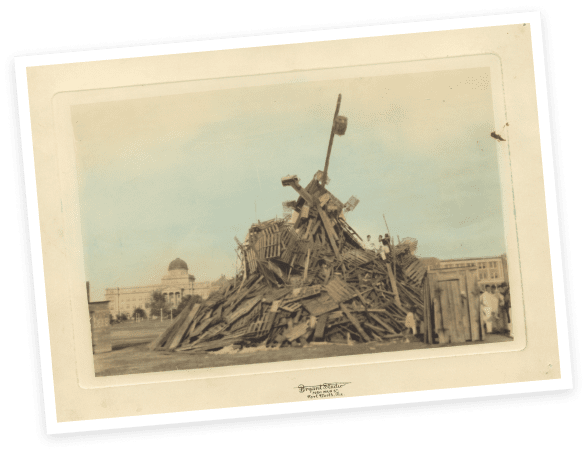
1928’s Aggie Bonfire on the drill field in front of the Academic Building was still the old “trash pile” style of bonfire.
Photo courtesy of Texas A&M Cushing Memorial Library & Archives
We can lose to everybody else, but that we must defeat A&M has long been the sentiment here, and it is the same on the Farmers’ side of the fence.
1911

UT breaks off football relations with Texas A&M after the 1911 game, amid claims that the Texas A&M teams played rough or “dirty” under coach Charley Moran. The football teams do not play again until 1915.
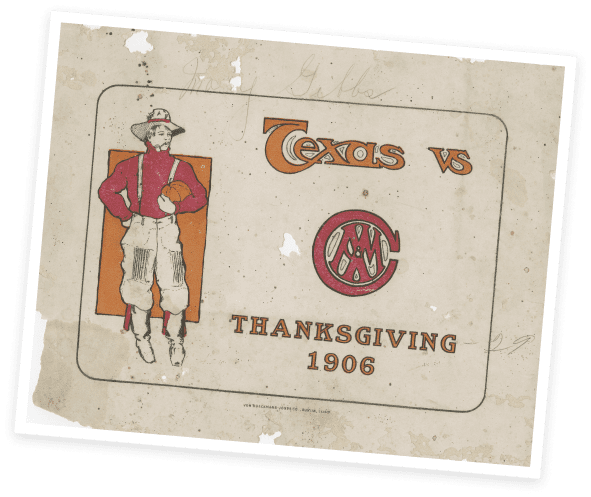
1906 football program courtesy of Texas A&M Cushing Memorial Library & Archives
1914

Southwest Conference forms, with Texas A&M and Texas among the charter members.
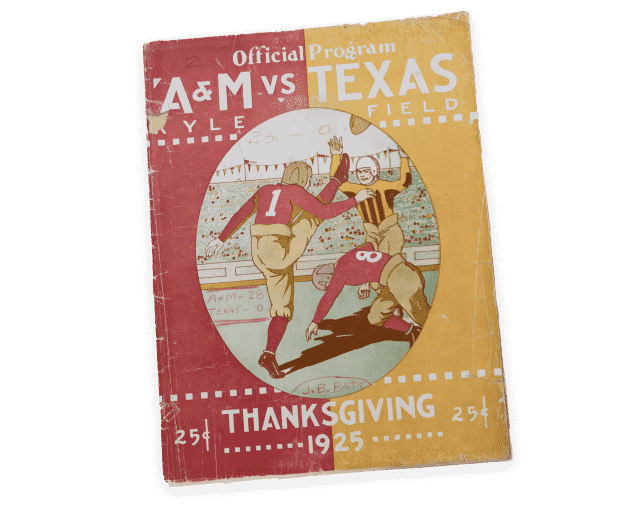
1925 football program courtesy of Texas A&M Cushing Memorial Library & Archives
1915

First Texas A&M/Texas game held in College Station. Earlier games had been held in Austin, San Antonio, Dallas and Houston. This 13-0 score is the one that will be branded on Bevo two years later.

1919 The Battalion image
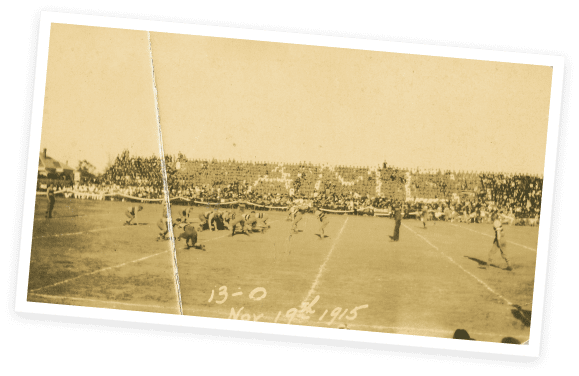
Photo courtesy of Texas A&M Cushing Memorial Library & Archives
Beat those people from Austin. If you still love me and think anything of me, then beat Texas.
1916


Texas introduces new longhorn steer mascot; his name is given as “Bevo” in a 1916 issue of the Texas Exes’ magazine.
Bevo didn’t get his name from being branded 13-0. The Longhorn mascot was named in 1916 and wasn’t branded until 1917. But the first Bevo was indeed barbecued… by UT, which invited Aggies to the banquet.
1917


Texas A&M students locate Bevo in South Austin and brand him “13-0,” the score of the 1915 win over Texas.

Photo courtesy of Texas A&M Cushing Memorial Library & Archives
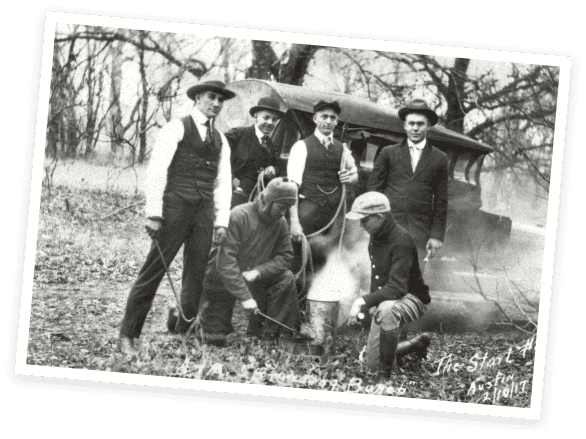
Photo courtesy of Texas A&M Cushing Memorial Library & Archives
1918

Aggie War Hymn composed by J.V. “Pinky” Wilson, Class of 1920, while serving in the Marine Corps during World War I. One of the song’s early titles is Goodbye to Texas University.
It’s true that the Aggie War Hymn names “Texas University.” But less well-known among Aggies is the fact that the second line of the Longhorns’ Texas Fight is “And it’s goodbye to A&M.”
1920


Texas decides Bevo’s upkeep is too costly and difficult, and opts to barbecue the steer for the football team’s January banquet. Aggies are invited and given the hide with “13-0” branded on it.
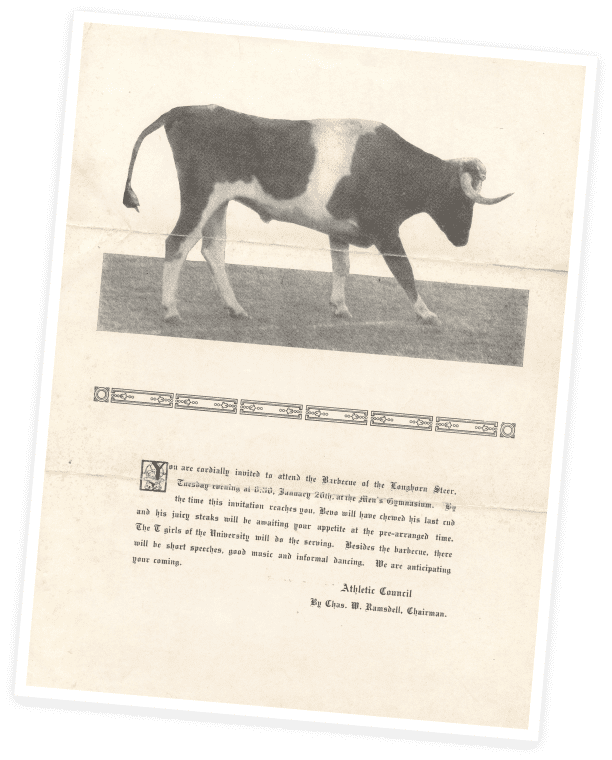
Photo courtesy of Texas A&M Cushing Memorial Library & Archives
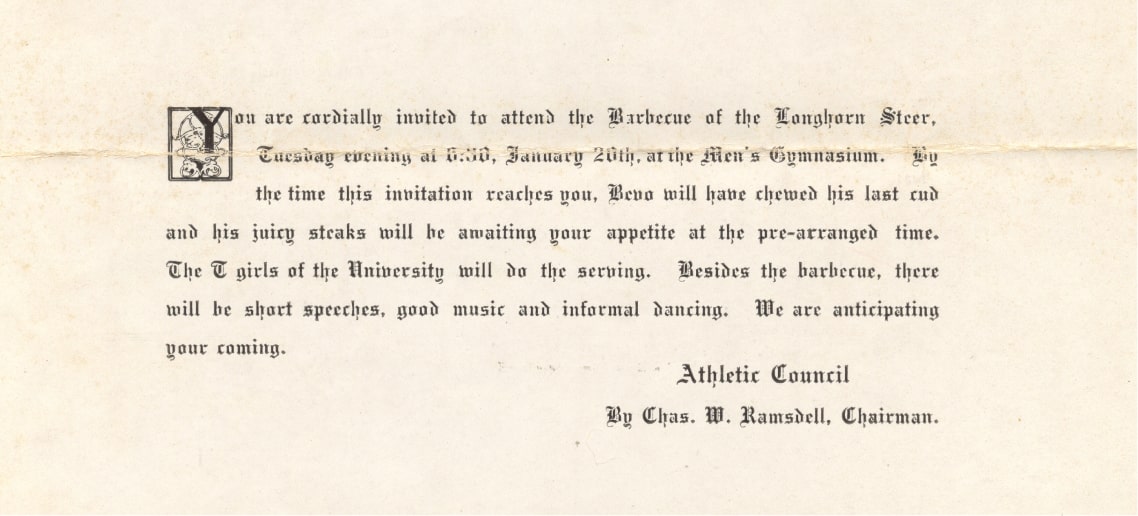
1921

Texas A&M electrical engineering students conduct the state’s first radio broadcast of a football game: live play-by-play coverage of the Texas A&M/UT game.
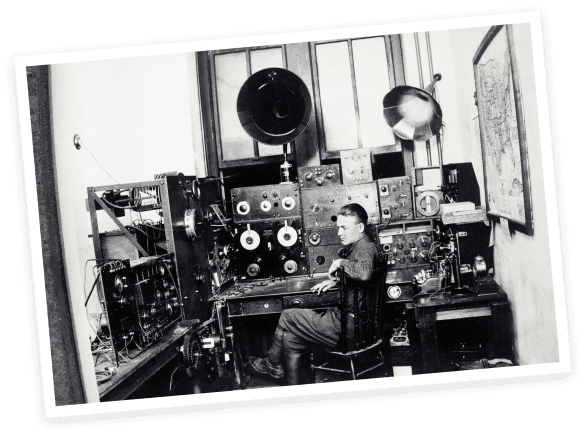
This early-1920s radio station at Texas A&M is the type of setup – possibly the very setup – that students used to send the first college football radio broadcast.
Photo courtesy of Texas A&M Cushing Memorial Library & Archives
1923

Texas Fight is first performed at the Texas A&M football game. First lines: “Texas Fight, Texas Fight, and it’s goodbye to A&M.” Written as response to an earlier Texas A&M fight song, Farmers Fight.
1930

The first school hand signal in the Southwest Conference is born: At a yell practice before Texas A&M’s 1930 game vs. TCU, Texas A&M regent Pinky Downs, Class of 1906, adds a “thumbs up” hand gesture to the phrase “gig ‘em” (which Aggies had been using since the 1910s).
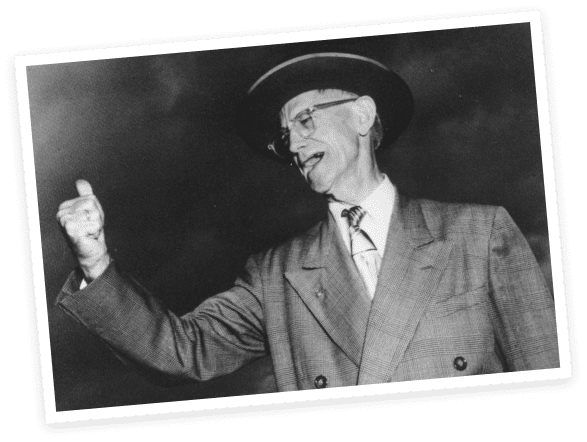
Photo courtesy of Texas A&M Cushing Memorial Library & Archives
1933

Rivalry lore claims that UT students attempted to light Texas A&M’s Bonfire early. The Battalion’s Nov. 22, 1933, story only identifies the culprits as “college radicals” and says though a fire was sparked, Aggie cadets successfully doused it. Bonfire burned as planned on Nov. 29, 1933.

Through the years, the crowds attending Aggie Bonfire grew, as this undated photo shows.
Photo courtesy of Texas A&M Cushing Memorial Library & Archives
1938


UT supporters apparently graffitied their own field, as game footage shows “BEAT A-M” marked on the grass of Memorial Stadium.
Aggie War Hymn author Wilson writes a new verse that doesn’t mention the University of Texas, with the intention that it can be used when Texas A&M is playing other schools. Periodic efforts are made over the next 80-plus years to promote the “new” verse, but Aggies mostly stick to singing the original words.
WATCH: Don’t miss the halftime clips of the Fightin’ Texas Aggie Band (starting at 13:18 – sadly, though, the film is silent) in this Texas A&M archive video of highlights from the Nov. 24, 1938, game between Texas A&M and UT.
Video courtesy of Texas A&M Cushing Memorial Library & Archives
1930s-70s

From at least the late 1930s through the 1970s, UT students regularly built bonfires before the Texas A&M game. In the early years, UT (like Texas A&M) sometimes built bonfires for games with other schools as well; bonfires were then and remain today a homecoming or pep rally tradition at schools nationwide.

Advertisement in the Nov. 13, 1952, Austin American
1941

UT students create the “Hex Rally” to jinx Texas A&M. Weary of losing eight straight away games at Texas A&M, they seek a fortune-teller’s advice and are advised to burn red candles before the game. During the 1950s and 1960s, UT students conduct occasional Hex Rallies against TCU, Baylor and SMU, but the tradition fades out until being revived in 1986.
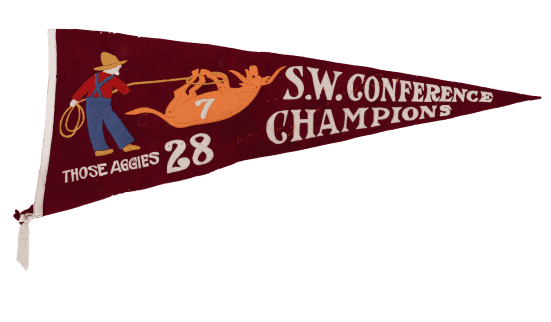
1928 pennant courtesy of Texas A&M Cushing Memorial Library & Archives/Photo by Melanie McBride ’23
1948

UT student “borrows” a plane and flies over the Texas A&M campus, dropping gasoline and flares in an unsuccessful attempt to light the Texas A&M Bonfire early.
1949

“Aggies” becomes the official name for Texas A&M students; it had been in casual use since the 1910s.
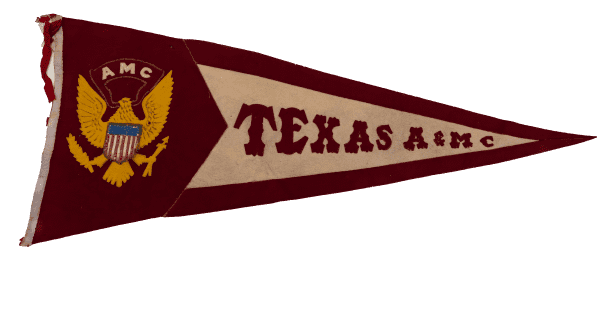
1928 pennant courtesy of Texas A&M Cushing Memorial Library & Archives/Photo by Melanie McBride ’23
1950

Texas A&M students sow oats on the field of UT’s Memorial Stadium to spell “A and M”; the stadium staff is only partly able to eradicate it.
1951

Seedlings planted on Kyle Field spell “TU.”
1955

Longhorns head cheerleader unveils “Hook ‘Em Horns” hand signal at a pep rally before UT plays TCU.
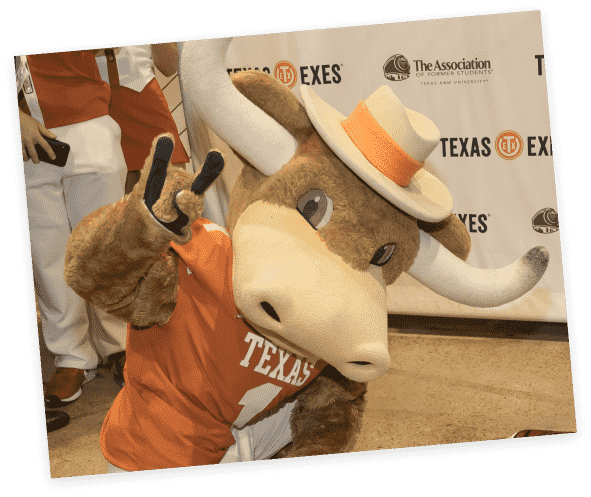
Photo by The Association of Former Students
1963



UT’s student newspaper shows a Baylor fan reversing the “Hook ‘Em Horns” hand sign into “Horns Down.”
Texas A&M students kidnap Bevo VII; the steer is located a day later. In retaliation, UT students reportedly pour chemicals on Kyle Field to spell “Bevo.”
1972


A group of Aggies succeed in briefly kidnapping Bevo IX after a failed attempt the month before by Rice students.
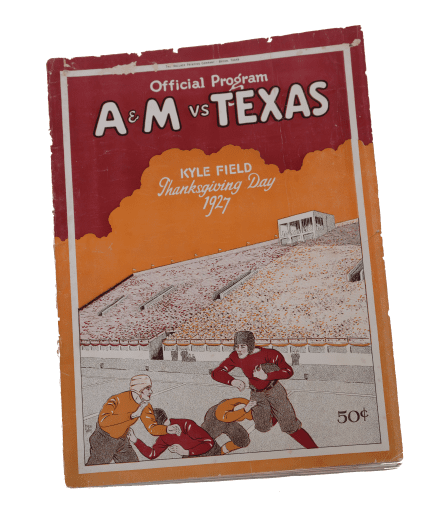
Photo by The Association of Former Students
1985

Among the loudest games in Kyle Field history: The roar of the 12th Man brought the game to a halt three times, as UT’s quarterback “refused to snap the ball because of crowd noise,” The Battalion reported. The third delay lasted over two minutes. Texas A&M’s 42-10 win is cited by many as the loudest game in Kyle before the 2015 stadium expansion created a more bowl-like shape.
WATCH: Video courtesy of ESPN / 12th Man Productions archives
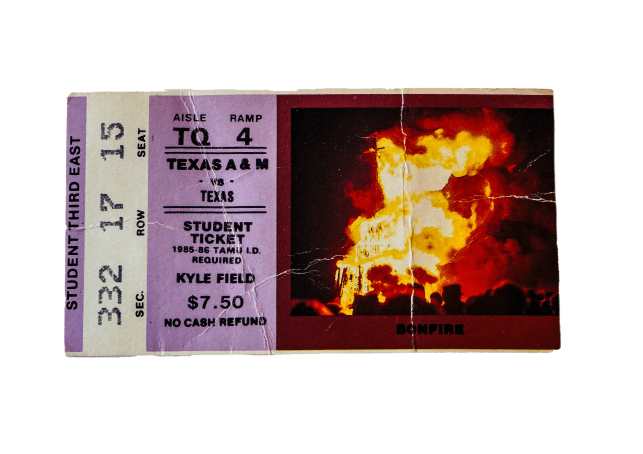
1985 ticket courtesy of Michelle McDaniel ’88; photo by Melanie McBride ’23
1986

UT revives its Hex Rally and begins holding it annually before the Texas A&M game.

Hundreds of Longhorn students turned out for the 2004 Hex Rally before the game against Texas A&M.
2004 photo © Jay Janner ’91 – USA TODAY NETWORK
1990

UT bars Texas A&M from bringing its cannon, saying “We didn’t have room.”
The Texas A&M Classes of 1988, 1989, 1990 and 1995 never lost to UT in football.
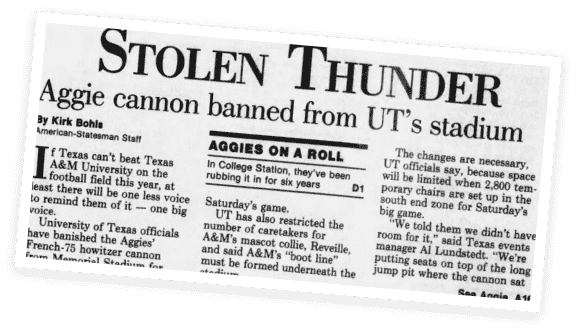
1990 Austin American-Statesman image
1993


Four-month-old Reveille VI is kidnapped in Dallas before the Cotton Bowl by a group of UT students, making headlines nationwide. She is returned nearly a week later.
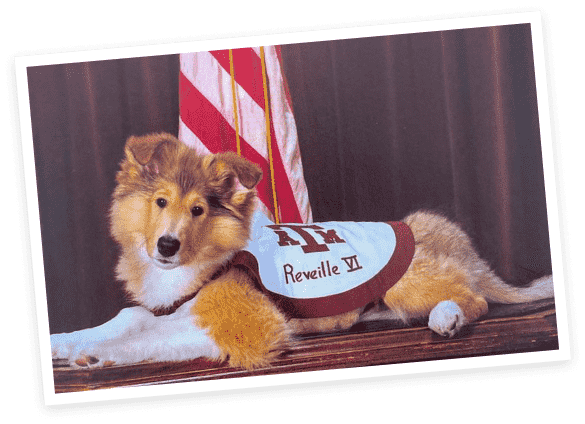
Photo courtesy of Texas A&M Division of Marketing & Communications
1999

Bonfire collapse kills 12 Aggies and injures 27 on Nov. 18. UT responds with sympathy and unity, including blood drives, a heartfelt letter from the UT student body president and converting the Hex Rally into a “Unity Gathering.” During the football game on Nov. 26, the Longhorn Band carries Texas A&M flags, plays “Amazing Grace” and “Taps,” then takes off their hats and leaves the field silently.
WATCH the stirring halftime band performances from the 1999 Texas A&M-UT game.
Video courtesy of Texas A&M Athletics
2003

The first Orange and Maroon Legislative Day is held at the state Capitol, with Aggies and Longhorns advocating for the shared goals of Texas A&M and UT. The event is organized every other year by The Association of Former Students and the Texas Exes.
With Aggies serving as Texas’ governor and Austin’s mayor, the Austin newspaper runs a guide to living under Aggie customs.
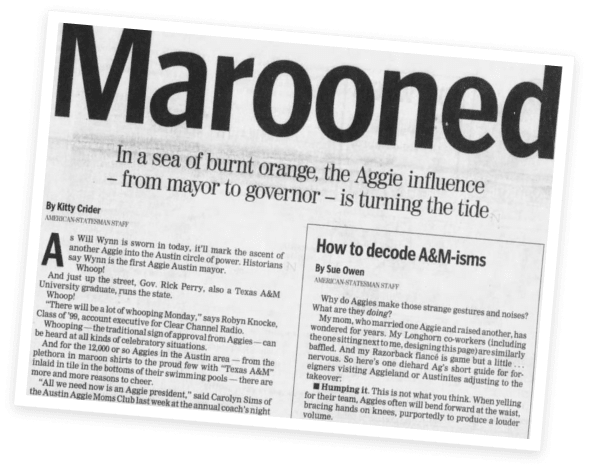
2003 Austin-American-Statesman image
2006

A UT student reserves the state Capitol building’s south steps to prevent Midnight Yell Practice being held there as usual. A Longhorn lawmaker withdraws the application, and Midnight Yell goes ahead at the planned site.

Aggies attend Midnight Yell Practice at the state Capitol in 1990. (Yell practices at away games were held at midnight through 2019; in 2021, the events moved to 10 p.m. to allow more attendees.)
Photo by Sue Owen ‘94
2011

The last Big 12 Conference football game between Texas A&M and UT. Though they meet occasionally in other sports – and speculation runs rampant that the football teams could meet in a bowl game or other non-conference game – the two schools would not compete in football again until 2024.

From left, UT fans Leslie Appel, Chad White and Shane White, Texas A&M fans Tyler Beam '11 and Genna Kopecki, and UT fan Chris Stewart show their spirit before the start of the 2011 Texas A&M-UT game at Kyle Field.
2011 photo © Jay Janner ’91 – USA TODAY NETWORK
2014

Maroon bluebonnets sprout on the UT campus, but their source remains a mystery.
2021

UT and OU reach an agreement to leave the Big 12 and join the SEC in 2025.
The Texas A&M Classes of 2016-2024 never played UT in football.
The Oklahoma rivalry was state versus state. The A&M rivalry was family vs. family.
2023

Longhorn alumni join Aggies for the annual cleaning of the Texas A&M Bonfire Memorial.

Photo courtesy of the Brazos Valley Chapter of Texas Exes
I used to tell my players that from the tall banks of Houston to the office buildings of Dallas to the deer blinds out in the Hill Country, wherever in this state, there’ll be a lot of people talking about this [game].
2024

Texas A&M and Texas resume their football rivalry on Nov. 30 – 130 years after the series began in 1894. Rather than wait until 2025, UT and OU had agreed in 2023 to pay Big 12 withdrawal fees to join the SEC a year early.

2022 photo by Brendall O'Banon '24/Texas A&M Athletics
AssociationSupport

Photo by The Association of Former Students
When you go to an Aggie gameday, you’ll see the work of The Association of Former Students everywhere. Your support helps fund not only scholarships and academics but also Texas A&M traditions and organizations such as Midnight Yell Practice, the Corps of Cadets, the Fightin’ Texas Aggie Band and Parsons Mounted Cavalry.
Be sure to visit Aggie Park, which The Association donated to the university in 2022. This 20-acre premier green space at the heart of campus was developed with private gifts from generous donors and is now used year-round by students and visitors for recreation, study, entertainment and more.
At home games, you can attend The Association’s free All-Aggie Hullabaloo event with food, drink and vendors, and even watch the game in comfort on the Huddleston Video Wall inside the Clayton W. Williams, Jr. Alumni Center, which is open to the public. The Association supports the pre-game flyovers and hosts Class Reunions. For away games, The Association coordinates and hosts yell practice with the Texas A&M yell leaders and hosts All-Aggie Headquarters at select games.
Personal Recollections Aggies Remember The Rivalry
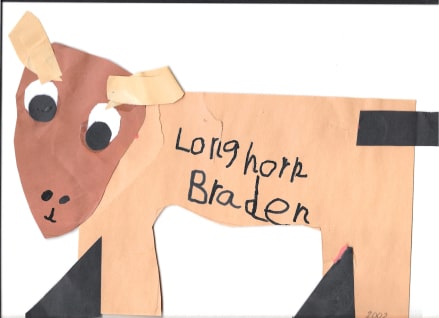

Photos courtesy of Braden Deupree ’18
At the 1977 A&M-Texas game in Kyle Field, I was a senior in Company C-1 (Cobra C), and we were the officers of the day for the game. Prior to the start of the game, the Texas students attempted to bring their large Texas flag onto the field, which was a forbidden demonstration on Kyle Field. As was our responsibility as ODs, we left the sideline and went out on the field to intercept them and prevent the incursion. Soon there was a crowd of ODs, yell leaders and Texas Cowboys in heated arguments in the middle of Kyle Field in a blending of olive drab, maroon, white and burnt orange. In the peak of the tumult, I heard someone yell my name. When I spun around, standing there in a Texas Cowboy outfit was a close family friend who I had grown up with in our neighborhood. We shook hands, embraced and began laughing at the crazy situation we found ourselves in. At that moment, someone in the crowd offered to take our picture, and I have included the resulting photo. Finally, the flag was withdrawn and the crowd dispersed peacefully. Although we were victorious in that initial struggle, the game did not go as well, and we were outscored. Regardless, the game remains a fond memory due to this picture and the "hands across the field" event, and I continue to keep the framed photo on display in my office.
When they met on Kyle Field in 1977, Mark Dinges, left, and Tim Malloy ’78 recognized each other: They were old friends who had grown up together.

Photo courtesy of Tim C. Malloy ‘78
The summer of 1998, my husband and I attended a lovely backyard wedding of two of our friends. The groom was a recent graduate of t.u. and incredibly boisterous regarding his affection for the university he had attended. Like any passionate supporter of a university, the groom had his cake represent his alma mater. Proudly piped in pumpkin-colored buttercream across the length of his cake was his beloved longhorn logo. Before the cake was cut and served, I approached another Aggie attending the wedding with a clever plan, to which he enthusiastically agreed. While the wedding party and attendees were casually milling about and engaged in lively conversation, the other Aggie and I each wielded a plastic knife in hand. At just the right moment, we flanked the groom’s cake, took our plastic cutlery and sawed those horns off! To this day, the groom is unaware that two Aggies at his wedding sawed Varsity’s horns off his cake.

Photo courtesy of Teri Brushaber ‘94
I had just moved to Austin in October of 1999 after taking a job with AM/FM Radio to do middays for KFMK 105.9. This cluster of stations also owned KVET 1300AM, the flagship Longhorn station. The morning that stack fell, my father called me in the middle of the night to tell me. I got dressed and made my way down to our downtown Austin studios. It was about 7:30 a.m. and the first person I saw was my Aggie co-worker Chad Hastings ’96, who just reached out and gave me a hug. Then the morning show for KFMK pulled me on the air and had me on for the next two hours talking about Bonfire, what it means to be an Aggie, the 12th Man and the Aggie Spirit. Our morning show guy was brilliant in retrospect. He was originally from Houston and knew all about us Aggies. I don’t know how I kept my composure that morning, but I pushed through and thought about how I had to represent the Ags. Before my actual air shift started, I needed a glass of water, and when I walked out of my studio, all of the sports guys from KVET, Bob Cole and Sammy Allred and the KASE morning show were standing outside in line to give me a hug and pass their love and support. The next few days as an Aggie in Austin were incredible. So many folks flying A&M flags across town. Craft stores ran out of maroon and white ribbon because people had decorated their cars in remembrance of the kids who were hurt and perished at Bonfire. I will always hold a special place in my heart for those few days where our rivalry didn’t matter.

Photo courtesy of Deana Romero ‘95
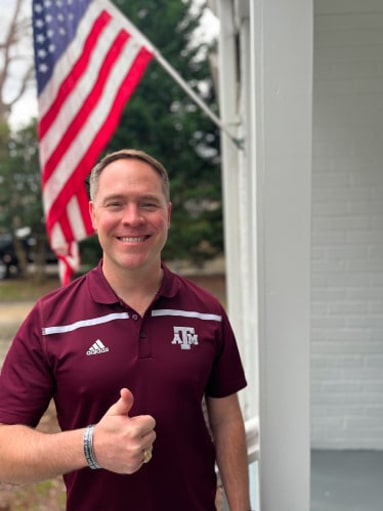
Jack Van Cleve IV ‘01
It has been said that our caliber and quality are judged by our peers. If this is true, we are in good company with the University of Texas. On Nov. 18, 1999, at 2:42 a.m., when the Aggie Bonfire stack collapsed, we and our fellow medics with Texas A&M University Emergency Medical Services responded to the scene and provided care and aid to our fellow students. As day broke, we received calls from EMS agencies around the state offering to help in any way they could. We didn’t have time to process what we had just experienced, much less grieve the loss of our fellow Aggies, because we had to prepare for a memorial Midnight Yell and a football game sure to draw record crowds. The University of Texas Emergency Medical Services offered to send medics and supplies. We agreed the best place for us to use them would be at the football game, since they have experience working such events. It was a rare sight seeing UT medics at Kyle Field with the burnt orange longhorn on their uniforms standing next to Aggie medics in theirs. Working hand in hand, we responded to emergency calls rendering aid to Longhorns and Aggies alike. When the halftime show started, the Longhorn Band’s performance was one of the most beautiful and emotional tributes we had ever seen. Even though it has been almost 25 years, the memories of that day and the days following are still fresh like it was yesterday. On that sunny, but somber afternoon at Kyle Field, our biggest rival became our biggest comforter in our time of need. We will always appreciate our Longhorn friends in Austin, especially the medics who stepped up to help us, and we are among many Aggies who feel this way. Gig ’em, Aggies, and Hook ’em, Longhorns!

Scott Kulle ‘99
Longhorns’ complaints may fuel rise of ‘Horns Down’
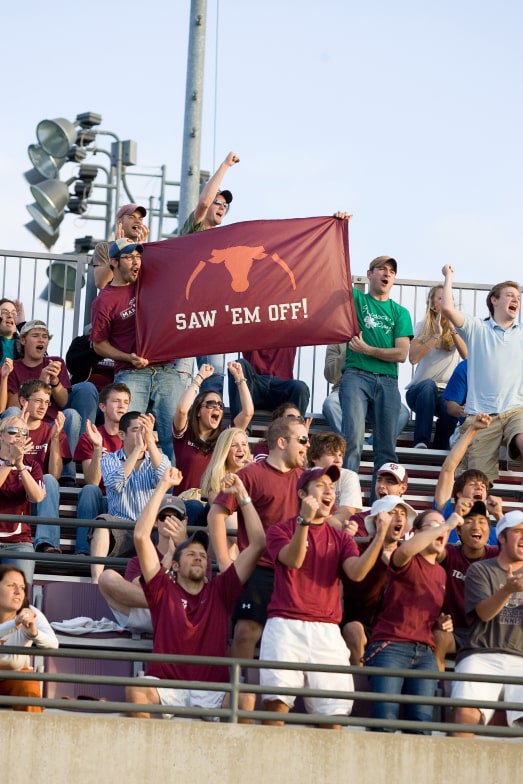
2009 photo courtesy of Texas A&M Athletics
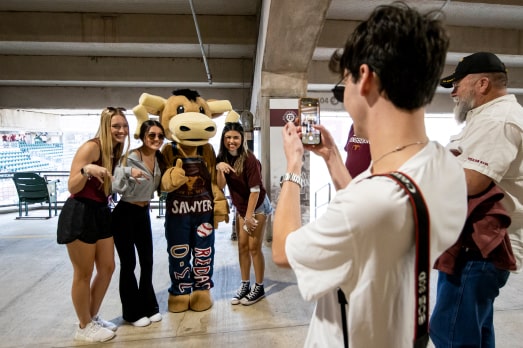
Aggies get ready for a 2023 baseball game against the Longhorns, taking a photo with the “Mr. Sawyer Horns” mascot from the Aggieland Outfitters store.
2023 photo by Brendall O'Banon ’24/Texas A&M Athletics
Former students are often puzzled: Why do many current Texas A&M University students flash a “horns down” at all kinds of events – even events unrelated to the University of Texas?
It’s common for other fanbases to show “horns down” when playing UT. Just this January, UT basketball coach Rodney Terry made headlines by yelling at University of Central Florida players for it.
But here? Most current Aggie students were 5 to 8 years old when Texas A&M left UT behind to join the SEC – yet you see “horns down” at many campus events, including games against other opponents.
To be sure, this is a pretty frivolous topic. But with the football game returning this fall, now might be the last chance to find out why the hand sign survived in Aggieland even without Thanksgiving matchups. So The Association of Former Students did an informal survey, with more than 350 current and former students responding.
And it turns out, in some ways, the Longhorns might have brought it on themselves.
First: Many former students said “horns down” was uncommon in their day or was mostly done by Oklahoma Sooners or other fanbases. (“Horns down” has probably been around since shortly after “hook ‘em horns” started in 1955; an early example is a Baylor fan photographed doing “horns down” in 1963.)
Then we looked closely at the responses from recent grads (specifically the Classes of 2016-2023, who never played UT in football) and current students (Classes of 2024-2027).
The most common theme in respondents who started at Texas A&M after 2011 was that the “horns down” sign is a unifying gesture for Aggies, a way to show their Aggieness and to hold with tradition.
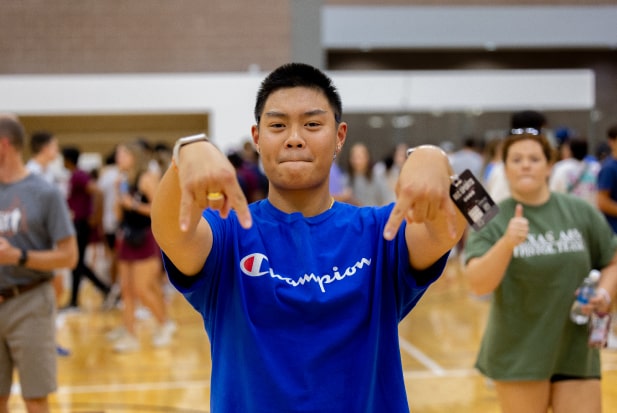
Photo by Racardo D. Davis/Texas A&M University Division of Marketing & Communications
Many students cited the longstanding rivalry, and some noted that sawing Varsity’s horns off is still part of the Aggie War Hymn, and that we still “gig ’em,” even though the hand gesture originated as a poke at TCU’s Horned Frogs.
A number of young Aggies said they restrict the “horns down” to UT-related contexts:
We are Aggies first, and we should be doing our own hand signal to show support for our school. Our identity is not UT's rival. Do horns down when we play the Horns. Gigs every other time.
Alex Guerrero ’20
I only use the horns down gesture if we play against a team that defeated the Longhorns or we happen to be ranked higher in some sport.
Hans Ortiz ’26
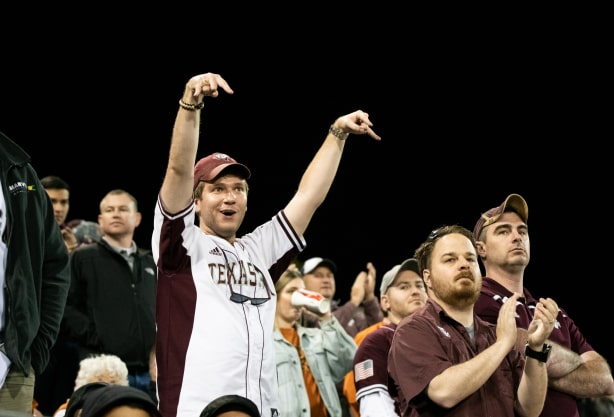
2019 photo by Cassie Stricker ’19/The Battalion
But the strongest secondary theme in the responses was simply that it annoys Longhorns. And that might have picked up a lot of steam starting in 2012.
That year, UT head football coach Mack Brown went viral after he told the press, “The horns down are disrespectful,” and suggested, “We ought to talk about that as a league.”
During the next decade, national headlines swirled around what some perceived as special treatment given to the Longhorns’ distaste for “horns down,” whether they were playing West Virginia or OU. The Big 12 Conference eventually said “horns down” would “probably” draw a penalty (the SEC has said the gesture will be handled case-by-case).
That may have fanned the flames among young Aggies:
It’s fun to get under their skins, especially if they feel so offended by it.
Andres Ying ’23
Any chance to even make them slightly annoyed is worth it.
Kyle Horning ’24
If they didn’t make it such a big deal (despite any claims that they don’t care), then it wouldn’t be so prevalent at both UT and non-UT related events.
John Bronold ’17
It doesn’t hurt that social media and televised sports almost guarantee a Longhorn will see it, no matter the event.
Paul Gray ’23
And finally, a significant contingent of young Ags said they use it as a way to “boo” (without booing) or taunt other teams, as a general sign of disapproval:
So there you have it: At least at this moment in history, the young Aggies and current students who use “horns down” view it as a unifying sign of being an Aggie, a way of taunting other fanbases and a way to rankle the Longhorns.
